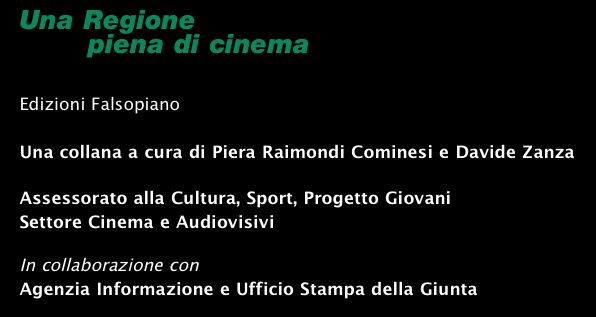 |
 |
 |
Comincia nel 1960 con il film L’avventura l’amicizia e la straordinaria collaborazione artistica tra Tonino Guerra, di Santarcangelo di Romagna, e Michelangelo Antonioni, di Ferrara, una solidarietà che, tra tanti successi internazionali, continua ancora oggi. Dieci film, dieci storie che hanno segnato il cinema italiano e non solo. Oggi vivono lontano, Tonino a Pennabilli nel Montefeltro, piccolo borgo antico nella valle del Marecchia, carico di storia e sede episcopale del Montefeltro; Michelangelo a Roma, mecca del cinema italiano, dove i due amici emigrarono in cerca di fortuna tanti anni fa. «Ero arrivato a Roma da Santarcangelo dove facevo l’insegnante nella scuola media, mi avevano aiutato Federico Fellini e Michelangelo Antonioni, c’era poca speranza, ci si vedeva ogni tanto, erano incontri pieni di idee e sogni... La nostra amicizia si traduceva anche in qualche corsa al mare di Romagna ed alcuni scherzi nella sua Ferrara. Ricordo che una volta mi portò in una strada di Ferrara e mi mostrò il negozio di un barbiere e mi disse: ”questo negozio in una notte l’abbiamo cancellato, e poi ci siamo messi a guardare da una vetrina di fronte mentre il barbiere ritornava e non riusciva a capire dove fosse finita la sua bottega”...». Come si svolgeva il vostro lavoro? «Giocavamo, scherzavamo e tra un momento e l’altro aprivamo delle riflessioni, buttavamo giù degli spunti, delle idee insieme, con Fellini facevo la stessa cosa, poi magari un giro in macchina, delle pause con momenti di un riposo ventoso, libero, per ritornare poi sulla sceneggiatura…». Quale è il film di Michelangelo che ami di più? «I film di Michelangelo che ricordo mi ritornano addosso come dei brandelli… certo Blow-up lo amo molto, lo amo tutto, amo anche i suoi racconti, stupendi, questa sua umidità del Po, me la sento addosso… questi suoi lavori da L’eclisse me li sento addosso, queste colonne bianche della banca, questo suo modo pungente di ricreare la realtà… aveva tanta voglia di dire delle cose in favore di un’aria pulita, di un’alba pulita. Ne Il Il deserto rosso ci sono già gli uccelli che muoiono, perché ci sono le nuvole di fumo dalle ciminiere delle fabbriche, non è vero che era distratto, che viveva una lontananza esistenziale». Qualcuno dice che Tarkovski si sia ispirato ad Antonioni, tu che hai lavorato con lui che cosa ne pensi? «Tutti hanno guardato ad Antonioni; per i registi stranieri è stato molto importante, Angelopoulos, Tarkovski, Polanski… gli insegnamenti di Antonioni sono enormi, sull’uso delle luci, sul primo piano, sul piano sequenza… tutto il mondo studia Antonioni e ricordo di avere letto delle lettere entusiaste dall’America per il film Il deserto rosso, perché era stato il primo che aveva usato il colore in un certo modo. Antonioni è un grande maestro che forse, se escludiamo Blow-up, non ha mai incantato una quantità enorme di gente, ma secondo me crescerà l’interesse verso il suo cinema; le immagini di Antonioni crescono avvicinandosi alle vere immagini di un pittore che però ti propone una pittura solo come la può dare il cinema». E come erano i suoi rapporti con gli attori, Monica Vitti, Gabriele Ferzetti, Marcello Mastroianni…? «Ho sentito qualcuno lamentarsi: “non dà spiegazioni… non ci aiuta… “ sono cose che non capisco, chi lavora con lui ha davanti un artista che sta creando immagini, quindi queste immagini producono parole… Quindi ritengo il problema degli attori secondario; è vero che non era un ripetitore di battute, un controllore feroce che ti stava addosso come un animale per indirizzarsi verso tutti i toni della battuta... ma lui aveva uno sguardo puntiglioso per la luce, per quello che ti creava sul viso e come ti presentavi… ho sempre pensato ad uno scultore che traduce le sue immagini in una forte immobilità… tra i suoi pittori più amati c’è Paolo Uccello e le sue battaglie, quei cavalli fermi, quel rumore e quel movimento che nasce; il movimento nasce dentro il nostro cervello, così succede la stessa cosa dentro le immagini di Antonioni… come compone le sue immagini? come chi arriva e si blocca, e crea sostanza per un racconto pieno di riflessioni». Se dovessi insegnare a giovani registi, come presenteresti il cinema di Michelangelo Antonioni? «Non si può insegnare nulla, non si può insegnare quello che ha fatto un altro; quando qualche giovane viene a trovarmi e mi chiede di altri registi gli chiedo sempre di parlare di se stesso, della sua umiltà, della sua tenerezza nel volere tentare di costruire un’immagine… questo è un patrimonio di Angelopoulos, la sua grazia e la premura di essere delicato in quello che vuole raccontare… la vera macchina da presa è dentro di noi e quindi è inutile che ti parli di un altro… Antonioni è bello, ricordo che fin dai nostri primi incontri ero molto colpito dalla sua eleganza, e lui rideva dei miei vestiti di velluto, non perché non gli piacessero, ma lui aveva un tono, un respiro, una linea che era fatta di eleganza…, ricordo come sedeva a tavola… parlavamo di sceneggiature, il suo modo partiva dalla non violenza, da qualche cosa che nasceva quasi con difficoltà di parole che diventava piano piano luce…». |
 |
It began in 1960 with the film THE ADVENTURE (L’AVVENTURA), the friendship and extraordinary artistic collaboration between Tonino Guerra, from Santarcangelo in Romagna, and Michelangelo Antonioni, from Ferrara, a friendship which still continues today, despite their many international successes. Ten films, ten stories which have left their mark on cinema history, both in Italy and beyond. Today they live far apart; Tonino in Pennabilli in Montefeltro, a small and ancient hamlet in Marecchia Valley, steeped in history, and site of the Episcopal See of Montefeltro; Michelangelo in Rome, the Mecca of Italian cinema, where the two friends emigrated to seek their fortune many years ago. Tonino is waiting for me in his study full of images and memories where every day artists of all kinds, journalists, directors, young people come to meet him, to ask for advice, for help, hoping to take away some of his secrets as a poet and screenwriter. “I had arrived in Rome from Santarcangelo where I was a middle school teacher, Federico Fellini and Michelangelo Antonioni had helped me, there was little hope, we saw each other once in a while, they were meetings full of ideas and dreams… Sometimes we would go to the sea in Romagna, or play practical jokes in his home city of Ferrara. I remember he once took me to a street in Ferrara and he showed me a barber’s shop and he said to me: “one evening we covered up his shop, and then we watched from a window opposite for the barber to return and he couldn’t understand where his shop had gone...” And he laughs thinking of that prank. “He was a happy man” Tonino continues, “and inside him there was a great sense of humour and laughter, and a love of jokes and games. Our work, our artistic commitment for the 10/11 films that we made together, from 1960 to today, it was like a challenge, like throwing a screwed-up ball of paper into the waste paper basket, like scoring a goal between the legs of a table. I lived in Piazza Clodio in Rome, and we challenged each other to a race to the fifth floor, I took the lift and he went up the stairs on foot. When I arrived I found him already inside the apartment, seated and smiling. This is Michelangelo Antonioni. His choices for what is worth seeing and reading are scented... He is the man who, during the period of Neorealism (that world full of rags), spotted a fur around the neck of Lucia Bosè in STORY OF A LOVE AFFAIR (CRONACA DI UN AMORE), and this fur was like a barrier against poverty; it was not that he did not love or have no regard for poverty, but it was like a desire, a hope… he wanted to focus on the middle classes, the problems Pavese had recounted in DIALOGUES WITH LEUCO’ (DIALOGHI CON LEUCO’), a book he loved and considered difficult and mysterious. It is not that he did not particularly care for dialogues, but images were very important to him. That immobility, giving the whole story of that account in the first shot: in that immobility, in those movements so slow and so full of mysterious substance to be narrated…”
|
 |